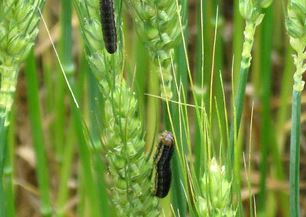
Weekly, Oklahoma State University Extension Beef Cattle Nutrition Specialist Paul Beck offers his expertise on the beef cattle industry. This is part of the weekly series known as the “Cow Calf Corner,” published electronically by Dr. Derrell Peel, Mark Johnson, and Beck. Today, Beck talks about Fall Armyworms being a Threat to Newly Planted Wheat.
Rains this summer have given a great opportunity for what pasture this fall. There have been many reports of large populations of fall army worms feeding on volunteer wheat and other cool-season annuals in crop fields. Tillage as we prepare seedbeds for planting can remove host vegetation and disrupt habitat but has varied effect on the life cycle of fall armyworms. As wheat planting progresses across Oklahoma, producers need to be vigilant—fall armyworms can quickly erode stand vigor and reduce grazing potential.
Identification
Adult moths span about 1½ inches. Males have dark gray, mottled wings with a pale diagonal stripe and a white tip spot; females are duller gray-brown. Eggs are laid in masses of 50–200 and covered with fuzzy scales. Mature larvae reach around 1½ inches long, with green, brown, or nearly black coloration, four small black spots per abdominal segment, and a distinctive pale, inverted “Y” on the head.
Life Cycle
These pests don’t overwinter in Oklahoma. They migrate north each summer from the Gulf Coast, Texas, or Mexico, typically arriving by late June. Generations overlap into October or November, with each female laying approximately 1,000 eggs—leading to rapid population growth (Royer et al., EPP-20-25; OSU Wheat Update, Oct 2024).
Damage
Seedling wheat is highly vulnerable to fall armyworm damage. Feeding by small armyworms creates a “windowpane” effect—scraped-off leaf tissue leaving a translucent membrane. Heavier feeding by larger armyworms can strip plants bare, weakening stands and delaying tillering (OSU Wheat Update, Oct 2024).
Scouting & Thresholds
Scout fields closely from emergence onwards. Check lodged or dense areas first. Use a square-foot sampling tool or count per linear foot of row:
- Common threshold: 2–3 larvae per linear foot of wheat row.
- Smaller caterpillars (<½ inch) are much easier to manage—act early.
Management
- Timing: Target early morning or late evening applications of pesticides.
- Products:
- Pyrethroids—economical but short-lived and easily washed off.
- IGRs (e.g., Intrepid) work on small larvae but require ingestion and lack rainfastness.
- Chlorantraniliprole-based products (e.g., Vantacor)—provide longer, rainfast control across larval sizes.
- Labels matter: Always follow label instructions, especially grazing restrictions.
Additional Considerations
Warm weather accelerates both armyworm development and treatment effectiveness. Natural enemies—parasitic wasps, flies, viruses—help but aren’t sufficient to prevent outbreaks. If fungicide is already planned, a tank mix with an insecticide may be efficient.
Key Takeaways
Fall armyworms are an annual threat to Oklahoma wheat—particularly for fields planted for dual-purpose grazing. Prevent forage loss through prompt scouting and early action. For current recommendations and support, contact your local OSU county Extension office.
“We will not get relief from fall armyworms until we get a killing frost, so keep vigilant!” Amanda Silva, OSU Cooperative Extension Small Grazing Specialist
References
- Royer TA and Seuhs K. 2021. Fall armyworms may become a problem in turf and grass pastures. EPP-20-25. Oklahoma Cooperative Extension Service, Stillwater, OK. Available: OSU Turfgrass Science site.
- Faris A. 2025. Armyworms in Wheat. EPP-25-18. OSU Extension e-Pest Alert, May 2025.
- Silva A. 2024. Wheat update – planting and fall armyworm, OSU Wheat blog, Oct 11, 2024. https://osuwheat.com/2024/10/11/wheat-update-planting-and-fall-armyworm/

















